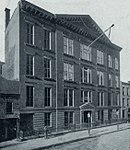The Salvation Army Headquarters is a building at 120–130 14th Street in the Chelsea and Greenwich Village neighborhoods of Manhattan in New York City. The building, owned by charitable organization the Salvation Army, is composed of a four-story auditorium named the Centennial Memorial Temple, a 12-story office building, and a 17-story dormitory named the Markle Evangeline. All three sections were designed in the Art Deco style by Ralph Thomas Walker of Voorhees, Gmelin and Walker and were constructed from 1928 to 1930 as the headquarters for the Salvation Army. The auditorium and office building are also New York City designated landmarks.
The building contains a facade of cast stone and buff brick. The office wing on 14th Street is sparsely decorated, although Walker used brick and cast stone, as well as stepped archways, to create a textile-like appearance. East of the office wing is the Centennial Memorial Temple. which has a triple-story opening whose design was intended to welcome visitors. The dormitory, in the rear of the building, contains setbacks to comply with the 1916 Zoning Resolution. The building's main auditorium had between 1,600 and 2,000 seats, while the dormitory had 220 rooms that were originally reserved for women. The building also had a recreation center and offices for the Salvation Army.
After the Salvation Army's cofounder Catherine Booth died in 1890, members decided to build a New York City headquarters in her honor. Catherine Booth's son Ballington Booth acquired land on 14th Street in 1893 and hired Gilbert A. Schellenger to design an eight-story headquarters, which was officially dedicated in June 1895. The Salvation Army also added a women's home at the rear of the building in December 1900. In its early years, the building hosted various programs and events, causing the existing headquarters to become overcrowded by the 1920s. Walker designed a new headquarters for the structure, which was built in stages from October 1928 to June 1930. The new building was the Salvation Army's national headquarters until 1981 and was a regional headquarters until 1990. The Salvation Army continued to use the structure to host events and renovated the building in the early 21st century.








